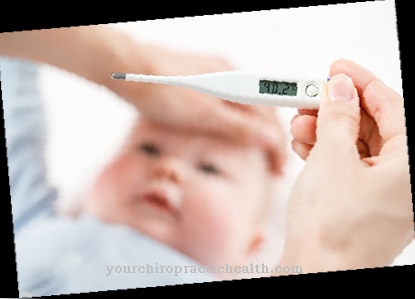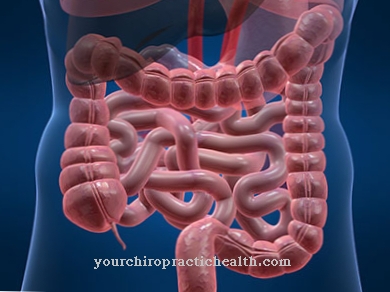The bacterial endocarditis is an inflammatory disease of the lining of the heart. It is caused by germs that get into the bloodstream and lodge in the heart. The earliest possible administration of an antibiotic is crucial for successful treatment.
What is bacterial endocarditis?

© peterjunaidy - stock.adobe.com
Bacterial endocarditis is an inflammation of the inner lining of the heart caused by bacteria. The heart wall consists of several layers of tissue, the innermost one being the endocardium. It is a thin, smooth and very fibrous skin that lines the heart and the heart chambers from the inside.
The heart valves and tendons also consist of endocardium. Bacterial endocarditis can therefore also damage the heart valves and lead to heart valve insufficiency (heart valve weakness). Bacterial endocarditis is divided into two groups depending on the pathogen. The acute form is triggered by staphylococci and has a shorter course with pronounced symptoms.
Subacute bacterial endocarditis is usually caused by streptococci and is much slower and milder. Bacterial endocarditis is more common in men than women. The patients are usually older than 60 years.
causes
Bacterial endocarditis is caused by pathogens that enter the bloodstream through foci of inflammation in the body. Often these inflammations are not even noticed by those affected. Germs can also get into the body through medical interventions on blood vessels, such as through a permanent access to a vein.
The causative agents of subacute bacterial endocarditis, the streptococci, are found on the skin or on the mucous membranes without being harmful there. Only when they get into the blood system do they cause inflammation. This can happen, for example, with tooth extractions (pulling the tooth).
These germs can also get into the bloodstream and thus into the heart via inflammation in the gastrointestinal tract or in the urinary tract. Streptococci are less aggressive pathogens and only cause the mild, subacute variant of bacterial endocarditis.
The acute form of the disease is usually caused by the much more aggressive staphylococci, but also by gonococci or pneumococci. They can enter the body through a central catheter or through the use of contaminated syringes. Bacterial endocarditis of the acute form can also occur after heart operations.
Symptoms, ailments & signs
Depending on how aggressive the pathogen is, different symptoms can occur with bacterial endocarditis. In less severe cases, there is a fever and weakness. Those affected feel exhausted and tired, and cardiovascular problems occasionally occur. A typical symptom is chills, which are usually accompanied by night sweats.
In addition, there is a loss of appetite, which quickly leads to weight loss. In the acute form of bacterial endocarditis, these symptoms can rapidly increase in intensity and cause severe damage to blood vessels and organs. The heart is particularly affected - here the disease manifests itself, among other things, by the characteristic stinging and occasionally also by cardiac arrhythmias.
If it is scarlet fever, symptoms such as a sore throat, nausea and vomiting, as well as headache and body aches, can occur. A little later there is the typical rash, which can be recognized by the red spots the size of a pinhead. A middle ear infection can cause hearing problems, pain in the affected ear canal and fever.
A sinus infection may show up as difficulty breathing and discharge. If bacterial endocarditis is an inflammation of the cornea of the eyes, visual disturbances, purulent discharge and other symptoms can occur.
Diagnosis & course
Subacute bacterial endocarditis is very slow and insidious. It begins with general symptoms such as fatigue, low fever, tiredness and loss of appetite.
In the further course, night sweats and changed heart murmurs appear. Acute bacterial endocarditis shows similar symptoms, but they are much more severe. The fever becomes so high that the patient may become unconscious. There is a risk of septic shock, which means the complete breakdown of the circulatory system and thus an acute danger to life.
Suspicion of bacterial endocarditis can be determined through a physical exam and by discussing a history of any pre-existing heart or valvular defects. In a blood test, markers of inflammation and the number of leukocytes provide information about an infection. In order to find out the causative agent of bacterial endocarditis, pathogen cultures are created.
Complications
Bacterial endocarditis can lead to a variety of complications. Dangers are in particular from bacterial deposits on the heart valves, which can loosen and cause a blood clot as a result. Smaller emboli can lead to short-term failures, while large blood clots can result in a stroke.
In addition, depending on the size and location of the occurrence, embolisms can lead to kidney, intestinal and spleen problems; The result is flank pain, blood in the urine, intestinal obstruction and cramps. If the arms and legs are affected, the poor blood circulation causes attacks of pain and sensory disturbances, among other things.
In addition, embolisms can lead to the formation of Osler nodules or petechiae; the painful skin diseases can later trigger infections and leave permanent scars. Damage to the heart valves often leads to heart failure, which can lead to various secondary diseases such as anemia or blood pressure disorders.
In rare cases, bacterial endocarditis also leads to jaundice or glomerulonephritis, a disease of the kidneys and the immune system. The earlier the inflammation is detected, the more likely it is to recover without serious health consequences.
When should you go to the doctor?
If night sweats, body aches or loss of appetite occur over a long period of time, a doctor is recommended. Symptoms suggest subacute bacterial endocarditis, which is best treated promptly. At the latest, when the accompanying chills and a gradual rise in body temperature are noticed, a subacute inflammation of the inner lining of the heart can be assumed.
The acute form, which manifests itself as a racing heart and shortness of breath, must be treated immediately. Further warning signs are clouding of consciousness, exhaustion and a general decrease in well-being.
Outwardly, acute bacterial endocarditis manifests itself as small skin nodules, rounded hemorrhages on the retina, and pin-head-sized skin hemorrhages. If these symptoms are noticed, seek medical attention immediately. If embolisms or organ failure occur, the emergency services must be alerted.
Under certain circumstances, the person concerned must receive first aid until the emergency doctor arrives. Since a longer stay in hospital is likely, the relatives of the person affected should also be informed as soon as possible.
Doctors & therapists in your area
Treatment & Therapy
The treatment of bacterial endocarditis is primarily through the administration of antibiotics. It is important that the antibiotic therapy starts as soon as possible. The doctor learns what type of antibiotic must be administered from the pathogen cultures, because the various antibiotic drugs only work against specific pathogens.
Usually the antibiotics have to be administered in high doses and over a longer period of time. This is usually done in an inpatient manner via an infusion. Furthermore, the blood is liquefied by so-called anticoagulation (reducing the ability to clot). As a result, the blood becomes thinner and flows better and any blood clots on the heart valves, in which the germs settle, gradually dissolve.
The treatment of bacterial endocarditis must be carried out until no more pathogens can be detected in the blood. In very severe cases, a heart valve can be so damaged by bacterial endocarditis that it has to be replaced by an artificial valve in an operation. There may also be a need to surgically remove any heart tissue that has changed due to the inflammation.
Outlook & forecast
The prognosis of bacterial endocarditis depends on numerous different influencing factors. Above all, the origin of the bacterium is of particular importance in this disease.
The prospect of a cure is to be classified as critical if the pathogen does not react to the administration of commercially available antibiotics. The chances of recovery increase with a pathogen that can be fought quickly and successfully with the available medical options. In addition, the stability of the patient's immune system is decisive for a good prognosis. The healthier and younger the sick person is, the better their chances of recovery are normally. Children are not included.
Existing damage and diseases of the heart or the presence of another disease that weakens the organism have an unfavorable influence. Chronic diseases are considered unfavorable and significantly reduce the chances of success. Furthermore, finding the cause of the endocarditis is fundamental to the healing process. If the causes of the lining of the heart can be found and treated quickly, the prognosis improves.
The time of diagnosis and therefore the start of treatment are also important factors that must be taken into account. With a late start of treatment, hypersensitivity to antibiotics and a resistant germ, bacterial endocarditis can be fatal. This is independent of the age of the patient and his immune system.
prevention
If you have already had a heart operation or suffer from a heart disease and a dental operation or other medical intervention is pending, you can prevent bacterial endocarditis by taking a suitable antibiotic. In addition, as with the prevention of heart muscle inflammation, if you have a cold, flu or other illness, you should not do sports as this can have a serious impact on heart health. (See also: sudden cardiac death)
Aftercare
Follow-up care after treated bacterial endocarditis is lengthy and depends on the patient's recovery. Every person has different risks for the infection to flare up again or for bacterial endocarditis to recur.
After drug therapy, the heart is examined at regular intervals to check the tissue. Any infections that may reappear can be recognized quickly and treatment is timely. The controls are carried out at short intervals during and after the treatment; after a while they become rarer.
A resting ECG, echocradiography and blood tests are usually used for this. Children who have survived bacterial endocarditis are considered to be at increased risk of re-inflammation. This is why these follow-up examinations usually have to be carried out for a lifetime.
For those affected who are conspicuous and who have a fever after treatment, the creation of a blood culture is particularly relevant. This quickly shows whether the endocarditis pathogen may still have remained in the body.
Good dental health is considered a prophylactic measure because many endocarditis pathogens enter the body through the oral cavity. The patient should therefore strive for excellent dental health for a lifetime.
You can do that yourself
Medical treatment is the primary need for people diagnosed with bacterial endocarditis. The doctor will inform the patient whether and which self-help measures can be taken.
As it is a serious heart disease, all physical activity must be avoided. The patient must take it easy during antibiotic therapy. The actual symptoms can be alleviated by the known measures.
The characteristic fever can be relieved by warming the bed and an adapted diet, while pain is treated with gentle painkillers. Medical drugs are not always prescribed here. Even light preparations from nature often help, such as valerian or arnica. In the case of pronounced damage, however, comprehensive drug therapy is always necessary.
An operation must also be performed. After an operation on the heart, the patient must take care of himself and pay attention to any side effects. Heart valve replacement carries the risk of various complications, which is why close consultation with the responsible doctor is always advisable.
Further self-help measures depend on how severe the symptoms are and whether further complications arise in the course of recovery. In general, bacterial endocarditis that is recognized early and treated by a doctor resolves quickly and reliably, even without taking any measures.





.jpg)







.jpg)

.jpg)
.jpg)











.jpg)